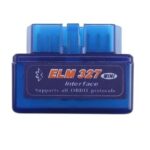Experiencing a check engine light in your 2014 Nissan Maxima can be concerning. Like many car owners, you might reach for your OBD2 scanner to diagnose the issue. But what if you plug in your scanner and… nothing happens? No lights, no connection – a completely dead OBD2 port. This was exactly the situation faced with a 2014 Maxima, referred to here as “Max IV.” After confirming the scanner worked on another vehicle (“Max III”), the problem was clearly isolated to the Maxima itself.
The initial thought might be a serious electrical malfunction. However, a seemingly unrelated prior incident provided a crucial clue. Weeks before, while working on an antenna replacement, a couple of 7.5 amp fuses in the “ELEC PARTS” slot had blown. This fuse, located in the fuse box (specifically, the 3rd row from the right at the top), was also known to affect the car’s clock function. Coincidentally, the clock was also non-functional in Max IV.
Could a blown “ELEC PARTS” fuse be the culprit behind a dead OBD2 port in a 2014 Maxima? The answer, surprisingly, is yes.
To illustrate the location of the “ELEC PARTS” fuse, refer to the image below, originally shared by Kevlo911:
As it turns out, there is a direct connection between the “ELEC PARTS” fuse and the OBD2 port functionality in a 2014 Maxima. Replacing the blown 7.5 amp “ELEC PARTS” fuse immediately restored power to the OBD2 port, and the clock started working again.
Troubleshooting a Non-Functional 2014 Maxima OBD2 Port
If you find yourself with a non-responsive OBD2 port in your 2014 Nissan Maxima, and perhaps a clock that’s also stopped working, here’s a quick troubleshooting step:
- Check the “ELEC PARTS” Fuse: Locate the fuse box in your 2014 Maxima. Consult your owner’s manual for the exact location if needed. Identify the “ELEC PARTS” fuse, typically a 7.5 amp fuse. It’s often located in the 3rd row from the right at the top of the fuse box.
- Inspect the Fuse: Visually inspect the fuse. A blown fuse will usually have a broken filament inside.
- Replace the Fuse: If the fuse is blown, replace it with a new 7.5 amp fuse.
- Test the OBD2 Port and Clock: After replacing the fuse, try connecting your OBD2 scanner again. Also, check if the clock is now functioning.
Why This Happens: Understanding the Electrical Connection
While the exact electrical circuit diagram isn’t detailed here, it’s clear that in the 2014 Maxima (and potentially similar Nissan models), the “ELEC PARTS” fuse circuit powers more than just “electrical parts” in a general sense. It specifically includes the OBD2 port and the clock. This means that a fault in a system powered by this fuse, or an overload causing the fuse to blow, will disable these seemingly unrelated components.
In the original case, the blown fuse was linked to a short circuit during an antenna replacement. This highlights that seemingly minor electrical work can sometimes have unexpected consequences on other vehicle systems.
Preventative Measures and Importance of a Working OBD2 Port
The lesson learned here is twofold:
- Address Electrical Shorts: If you experience repeated blown fuses, especially after electrical work, investigate for potential short circuits. In the case of the antenna, a faulty antenna cable or connection could be the culprit. Fixing the short will prevent future fuse issues and potential damage to other electrical components.
- Maintain a Functioning OBD2 Port: A working OBD2 port is crucial for modern vehicle diagnostics and maintenance. It allows you to read trouble codes, understand check engine light issues, and monitor various engine parameters. Being able to quickly diagnose problems via the OBD2 port can save time and money on car repairs.
In conclusion, if you’re facing a dead OBD2 port in your 2014 Maxima, don’t immediately assume a major malfunction. Checking and replacing the “ELEC PARTS” fuse is a simple first step that could resolve the issue and get you back to diagnosing and maintaining your vehicle effectively. Remember to address the root cause of any blown fuses to prevent recurrence and ensure all your car’s systems, including the vital OBD2 port, remain operational.
